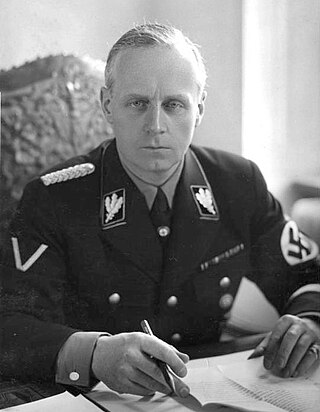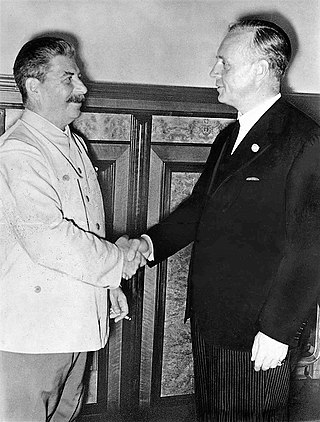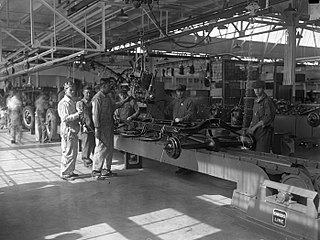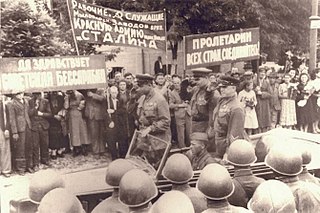
Ulrich Friedrich Wilhelm Joachim von Ribbentrop was a German politician and diplomat who served as Minister of Foreign Affairs of Nazi Germany from 1938 to 1945.

The Molotov–Ribbentrop Pact, officially the Treaty of Non-Aggression between Germany and the Union of Soviet Socialist Republics, was a non-aggression pact between Nazi Germany and the Soviet Union with a secret protocol that partitioned Central and Eastern Europe between them. The pact was signed in Moscow on 23 August 1939 by German Foreign Minister Joachim von Ribbentrop and Soviet Foreign Minister Vyacheslav Molotov. Unofficially, it has also been referred to as the Hitler–Stalin Pact, Nazi–Soviet Pact, or Nazi–Soviet Alliance.
Material requirements planning (MRP) is a production planning, scheduling, and inventory control system used to manage manufacturing processes. Most MRP systems are software-based, but it is possible to conduct MRP by hand as well.

In economics, profit maximization is the short run or long run process by which a firm may determine the price, input and output levels that will lead to the highest possible total profit. In neoclassical economics, which is currently the mainstream approach to microeconomics, the firm is assumed to be a "rational agent" which wants to maximize its total profit, which is the difference between its total revenue and its total cost.

The Anti-Comintern Pact, officially the Agreement against the Communist International was an anti-Communist pact concluded between Nazi Germany and the Empire of Japan on 25 November 1936 and was directed against the Communist International (Comintern). It was signed by German ambassador-at-large Joachim von Ribbentrop and Japanese ambassador to Germany Kintomo Mushanokōji. Italy joined in 1937, but it was legally recognised as an original signatory by the terms of its entry. Spain and Hungary joined in 1939. Other countries joined during World War II.

Seventeen days after the German invasion of Poland in 1939, which marked the beginning of the Second World War, the Soviet Union entered the eastern regions of Poland and annexed territories totalling 201,015 square kilometres (77,612 sq mi) with a population of 13,299,000. Inhabitants besides ethnic Poles included Belarusian and Ukrainian major population groups, and also Czechs, Lithuanians, Jews, and other minority groups.

German–Soviet Union relations date to the aftermath of the First World War. The Treaty of Brest-Litovsk, dictated by Germany ended hostilities between Russia and Germany; it was signed on March 3, 1918. A few months later, the German ambassador to Moscow, Wilhelm von Mirbach, was shot dead by Russian Left Socialist-Revolutionaries in an attempt to incite a new war between Russia and Germany. The entire Soviet embassy under Adolph Joffe was deported from Germany on November 6, 1918, for their active support of the German Revolution. Karl Radek also illegally supported communist subversive activities in Weimar Germany in 1919.
The German–Soviet Credit Agreement was an economic arrangement between Nazi Germany and the Soviet Union whereby the latter received an acceptance credit of 200 million ℛ︁ℳ︁ over 7 years with an effective interest rate of 4.5 percent. The credit line was to be used during the next two years for purchase of capital goods in Germany and was to be paid off by means of Soviet material shipment from 1946 onwards. The economic agreement was the first step toward improvement in relations between the Soviet Union and Germany.

Operations management is concerned with designing and controlling the production of goods or services, ensuring that businesses are efficient in using resources to meet customer requirements.

The Baltic Way or Baltic Chain was a peaceful political demonstration that occurred on 23 August 1989. Approximately two million people joined their hands to form a human chain spanning 690 kilometres (430 mi) across the three Baltic states of Estonia, Latvia and Lithuania, which at the time were occupied and annexed by the USSR and had a combined population of approximately eight million. The central government in Moscow considered the three Baltic countries constituent republics of the Soviet Union.
The military alliance between the United Kingdom and Poland was formalised by the Anglo-Polish Agreement in 1939, with subsequent addenda of 1940 and 1944, for mutual assistance in case of a military invasion from Nazi Germany, as specified in a secret protocol.

The Soviet occupation of Bessarabia and Northern Bukovina took place from 28 June to 3 July 1940, as a result of an ultimatum by the Soviet Union to Romania on 26 June 1940, that threatened the use of force. Those regions, with a total area of 50,762 km2 (19,599 sq mi) and a population of 3,776,309 inhabitants, were incorporated into the Soviet Union. On October 26, 1940, six Romanian islands on the Chilia branch of the Danube, with an area of 23.75 km2 (9.17 sq mi), were also occupied by the Soviet Army.

The Soviet invasion of Poland was a military conflict by the Soviet Union without a formal declaration of war. On 17 September 1939, the Soviet Union invaded Poland from the east, 16 days after Nazi Germany invaded Poland from the west. Subsequent military operations lasted for the following 20 days and ended on 6 October 1939 with the two-way division and annexation of the entire territory of the Second Polish Republic by Nazi Germany and the Soviet Union. This division is sometimes called the Fourth Partition of Poland. The Soviet invasion of Poland was indirectly indicated in the "secret protocol" of the Molotov–Ribbentrop Pact signed on 23 August 1939, which divided Poland into "spheres of influence" of the two powers. German and Soviet cooperation in the invasion of Poland has been described as co-belligerence.
Backflush accounting is a subset of management accounting focused on types of "postproduction issuing;" It is a product costing approach, used in a Just-In-Time (JIT) operating environment, in which costing is delayed until goods are finished. Backflush accounting delays the recording of costs until after the events have taken place, then standard costs are used to work backwards to 'flush' out the manufacturing costs. The result is that detailed tracking of costs is eliminated. Journal entries to inventory accounts may be delayed until the time of product completion or even the time of sale, and standard costs are used to assign costs to units when journal entries are made. Backflushing transaction has two steps: one step of the transaction reports the produced part which serves to increase the quantity on-hand of the produced part and a second step which relieves the inventory of all the component parts. Component part numbers and quantities-per are taken from the standard bill of material (BOM). This represents a huge saving over the traditional method of a) issuing component parts one at a time, usually to a discrete work order, b) receiving the finished parts into inventory, and c) returning any unused components, one at a time, back into inventory.
The 1940 German–Soviet Commercial Agreement was an economic arrangement between the Soviet Union and Nazi Germany signed on 11 February 1940. In it the Soviet Union agreed in the period from 11 February 1940 to 1941, in addition to the deliveries under German–Soviet Commercial Agreement, signed on 19 August 1939 to deliver commodities to the value of 420 to 430 million Reichsmarks.
The German–Soviet Border and Commercial Agreement, signed on January 10, 1941, was a broad agreement which settled border disputes, and continued raw materials and war machine trade between the Soviet Union and Nazi Germany. The agreement continued the countries' relationship that started in 1939 with the Molotov–Ribbentrop Pact, which contained secret protocols that divided Eastern Europe between the Soviet Union and Germany. The relationship had continued with the subsequent invasions by Germany and the Soviet Union of that territory. The agreement contained additional secret protocols, settling a dispute regarding land in Lithuania, which had been split between both countries. The agreement continued the Nazi–Soviet economic relations that had been expanded by the 1939 German–Soviet Commercial Agreement and the more comprehensive 1940 German–Soviet Commercial Agreement.

The Molotov–Ribbentrop Pact was an August 23, 1939, agreement between the Soviet Union and Nazi Germany colloquially named after Soviet foreign minister Vyacheslav Molotov and German foreign minister Joachim von Ribbentrop. The treaty renounced warfare between the two countries. In addition to stipulations of non-aggression, the treaty included a secret protocol dividing several eastern European countries between the parties.

After the Nazis rose to power in Germany in 1933, relations between Nazi Germany and the Soviet Union began to deteriorate rapidly. Trade between the two sides decreased. Following several years of high tension and rivalry, the two governments began to improve relations in 1939. In August of that year, the countries expanded their economic relationship by entering into a Trade and Credit agreement whereby the Soviet Union sent critical raw materials to Germany in exchange for weapons, military technology and civilian machinery. That deal accompanied the Molotov–Ribbentrop Pact, which contained secret protocols dividing central Europe between them, after which both Nazi forces and Soviet forces invaded territories listed within their "spheres of influence".

German–Soviet Axis talks occurred in October and November 1940 concerning the Soviet Union's potential entry as a fourth Axis power during World War II. The negotiations, which occurred during the era of the Molotov–Ribbentrop Pact, included a two-day conference in Berlin between Soviet Foreign Minister Vyacheslav Molotov and Adolf Hitler and German Foreign Minister Joachim von Ribbentrop. The talks were followed by both countries trading written proposed agreements.
The timeline of the occupation of the Baltic states lists key events in the military occupation of the three countries – Estonia, Latvia and Lithuania – by the Soviet Union and by Nazi Germany during World War II.











